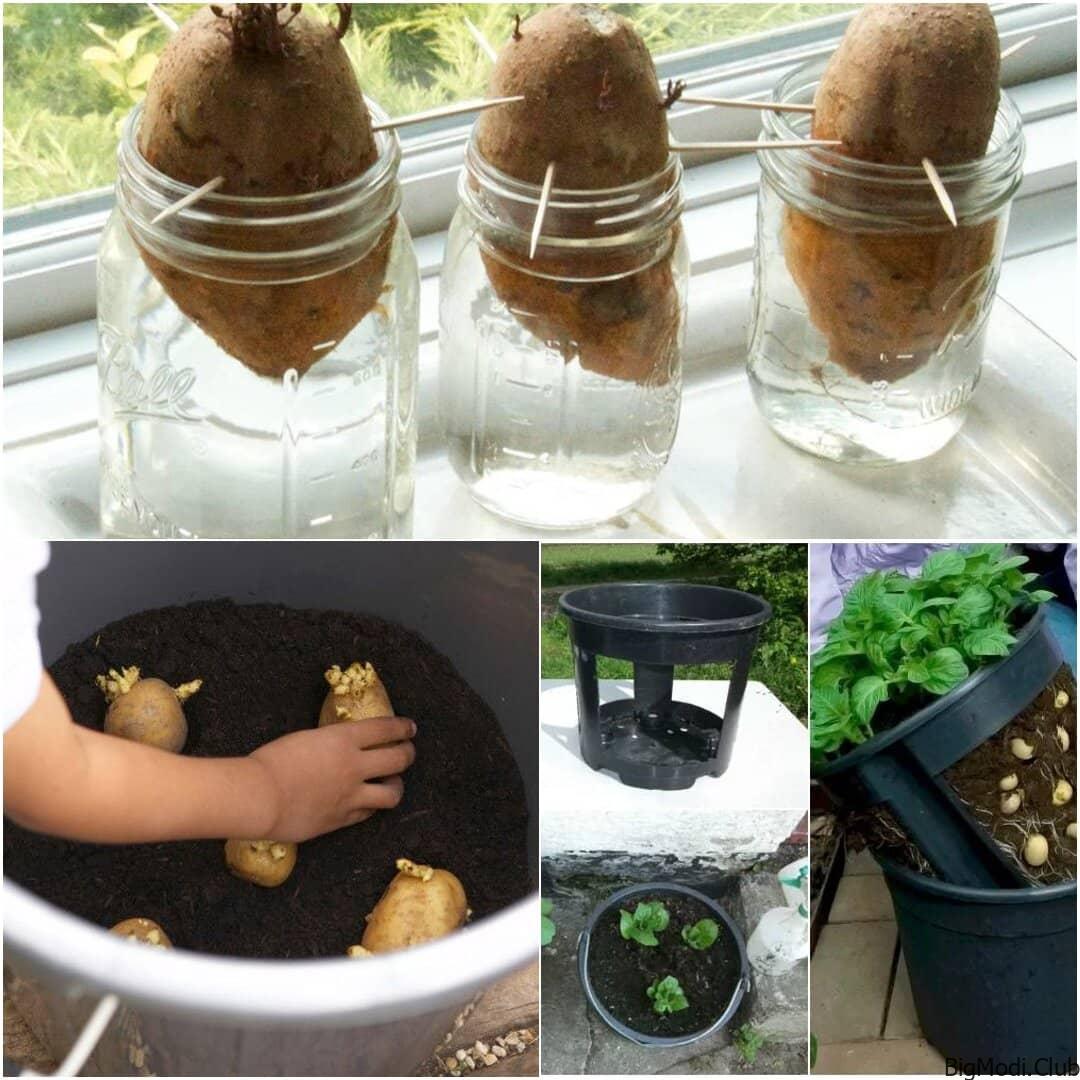When learning how to plant potatoes, understanding the different varieties is crucial for success. Potatoes can be categorized into three main types: First Early, Second Early, and Maincrop, each with its own planting and harvesting schedule. Knowing how to plant them properly, from preparing the soil to earthing up as they grow, will ensure a healthy crop.
In this guide, I’ll take you through the steps for planting and caring for potatoes, explore alternative methods for smaller spaces, and address common issues you might face during the growing season. Whether you have a garden, a patio, or just a balcony, there’s a method that will work for you!
Exploring the Different Types of Potatoes
When growing potatoes, it’s essential to understand the different types, as this will help you plan your planting and harvesting times.
First Early or ‘New’ Potatoes: These are the earliest to be harvested, usually around June and July. They are best enjoyed fresh because they don’t store well. Think of them as the delicate, quick-to-enjoy potato type, perfect for early summer meals.
Second Earlies (‘New’ Potatoes): These follow closely behind, harvested in July and August. Like their first-early counterparts, they’re best eaten fresh and are often used in lighter, summer dishes.
Maincrop Potatoes: Harvested later, between August and October, these are your all-rounders. They’re great for baking, roasting, and mashing, and the best part is—they can be stored for several months, making them perfect for winter meals.
The Right Way to Plant Potatoes
Before diving into planting, preparation is key. Start by removing any weeds and thoroughly digging up the soil. Aim to dig trenches that are about 12cm deep and leave 60cm between each trench to give your potatoes room to grow.
Once the soil is ready, it’s time to plant. In the spring, space your seed potatoes 30cm apart in the trenches and cover them with soil. Don’t worry—your potato plants will take off from there!
Earthing Up: A Critical Step
As the potato plants grow, and once the shoots reach about 20cm tall, you’ll want to start earthing up. This simply means pulling soil around the base of the shoots, covering the stems halfway. This process helps protect the potatoes from sunlight and ensures a better yield.
Alternative Methods
If space is an issue, don’t worry! You can easily grow first and second early potatoes in large bags or pots. Patios or balconies work perfectly for this method, making it easy for those without a garden to enjoy homegrown potatoes.
When to Plant Your Potatoes
Timing is everything when it comes to planting potatoes.
- First Early Potatoes: These can be planted as early as mid-March.
- Second Earlies: Give it a couple of weeks after planting first earlies, and you’re good to go.
- Maincrop Potatoes: Generally, April is the best time to plant, though this depends on the climate and frost risks in your region. In warmer areas, a second batch of maincrop potatoes can even be planted in late summer for a delightful Christmas harvest!
Chitting Potatoes: Boosting Your Yield
Before planting, don’t forget to chit your seed potatoes. This involves placing them in trays or egg cartons, with the end that has the most eyes facing upwards. Leave them in a cool, light place to develop 1-2cm long shoots. This process typically takes around six weeks but is worth it for a larger crop.
Creating the Perfect Growing Environment
When choosing a site for your potatoes, aim for an open, sunny spot. Potatoes grow well in most soils, but richer soil—especially one enriched with organic matter—will yield even better results.
If you’re growing early or salad potatoes in containers, consider using polypropylene bags specifically designed for potato growing, or even a repurposed compost bag. These options are fantastic for those with limited space.
Caring for Your Potato Plants
Watering is crucial, especially during warm, dry spells. Keep the soil consistently moist but avoid overwatering. As your plants continue to grow, you’ll need to keep earthing up to protect the developing tubers from sunlight and prevent them from turning green and inedible.
Troubleshooting Common Potato Problems
Like any plant, potatoes can face a few challenges.
- Slugs can be a nuisance, particularly when potatoes are grown under black plastic.
- Potato Blight is a more severe issue. This fungal disease causes yellowing leaves and rotting tubers. To avoid it, grow blight-resistant varieties, or cut down the plants as soon as you spot any infection to stop the fungus from spreading to the tubers.
Another important tip—rotate your crops. Don’t plant potatoes in the same soil every year to avoid pests like potato eelworm, which stunts growth and reduces your yield.
Harvesting: When and How
The best part of growing potatoes is, of course, the harvest!
- First Early Potatoes: Ready in June and July, they can be harvested when the plants are still flowering.
- Second Earlies: Ready in July and August, harvest these in the same way as first earlies.
- Maincrop Potatoes: Harvest these between August and October, after the leaves have turned yellow and died back. For best results, pick a dry day to dig up your crop.
If you’re growing potatoes in pots, simply tip them out and gather the rich harvest.
Storing Potatoes for Long-Term Use
When it comes to maincrop potatoes, proper storage is essential if you want them to last. Store them in a cool, frost-free place. Only keep perfect tubers, as any damaged ones will rot quickly. Ensure they’re kept in the dark to prevent them from turning green and toxic. Hessian or thick paper sacks are ideal for storage, and check on your stored crop regularly to remove any that are starting to rot.
With proper care and attention, growing potatoes can be a rewarding and fruitful experience, bringing a versatile and delicious crop into your home year-round!
FAQs
How to Sprout Potatoes?
To sprout potatoes, also known as “chitting,” place seed potatoes in a tray or egg carton with the end that has the most eyes facing upwards. Keep them in a cool, light area (around 50°F/10°C) for 4-6 weeks. Shoots will begin to form, and once they reach about 1-2 cm in length, they are ready to plant.
How Long Does It Take Potatoes to Grow?
The time it takes for potatoes to grow depends on the variety. First Early potatoes take around 10-12 weeks to mature, Second Earlies need about 13-15 weeks, and Maincrop potatoes typically require 20-22 weeks to reach full maturity.
How to Grow Potatoes from Eyes?
To grow potatoes from eyes, cut a seed potato into chunks, making sure each piece has at least one “eye” (the small sprout). Let the cut pieces dry for a day to prevent rotting, then plant them about 12 cm deep with the eyes facing upwards. Cover with soil, and they will start to grow.
How Deep to Plant Potatoes?
When planting potatoes, dig trenches that are 12 cm deep. Place the seed potatoes in the trench with 30 cm between each piece. Once the plants start growing, continue to mound soil around the stems to protect the tubers from sunlight.
How to Grow Potatoes from Potatoes?
To grow potatoes from potatoes, start by selecting healthy seed potatoes, which can be bought from garden stores. Cut the seed potatoes into chunks, ensuring each piece has at least one eye. Allow the cut pieces to dry for a day, then plant them in soil about 12 cm deep. Cover the pieces, and as they grow, mound soil around the stems to encourage a healthy crop.


